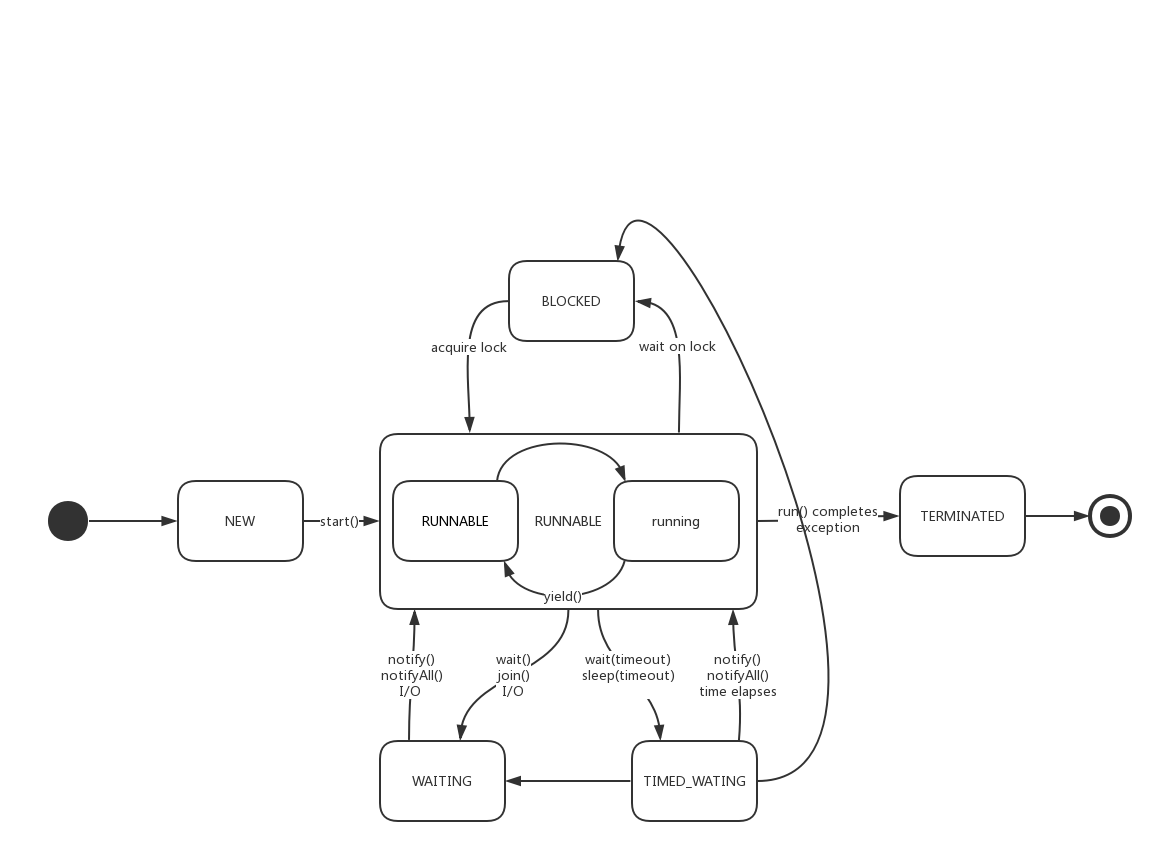Java中Thread.join()的使用方法
概要
本文分三個(gè)部分對(duì)Thread.join()進(jìn)行分析:
1. join() 的示例和作用
2. join() 源碼分析
3. 對(duì)網(wǎng)上其他分析 join() 的文章提出疑問
1. join() 的示例和作用
1.1 示例
// 父線程public class Parent { public static void main(String[] args) { // 創(chuàng)建child對(duì)象,此時(shí)child表示的線程處于NEW狀態(tài) Child child = new Child(); // child表示的線程轉(zhuǎn)換為RUNNABLE狀態(tài) child.start(); // 等待child線程運(yùn)行完再繼續(xù)運(yùn)行 child.join(); }}
// 子線程public class Child extends Thread { public void run() { // ... }}
上面代碼展示了兩個(gè)類:Parent(父線程類),Child(子線程類)。
Parent.main()方法是程序的入口,通過Child child = new Child(); 新建child子線程(此時(shí) child子線程處于NEW狀態(tài));
然后調(diào)用child.start()(child子線程狀態(tài)轉(zhuǎn)換為RUNNABLE);
再調(diào)用child.join(),此時(shí),Parent父線程會(huì)等待child子線程運(yùn)行完再繼續(xù)運(yùn)行。
下圖是我總結(jié)的 Java 線程狀態(tài)轉(zhuǎn)換圖:

1.2 join() 的作用
讓父線程等待子線程結(jié)束之后才能繼續(xù)運(yùn)行。
我們來看看在 Java 7 Concurrency Cookbook 中相關(guān)的描述(很清楚地說明了 join() 的作用):
Waiting for the finalization of a thread
In some situations, we will have to wait for the finalization of a thread. For example, we mayhave a program that will begin initializing the resources it needs before proceeding with therest of the execution. We can run the initialization tasks as threads and wait for its finalizationbefore continuing with the rest of the program.For this purpose, we can use the join() method of the Thread class. When we call thismethod using a thread object, it suspends the execution of the calling thread until the objectcalled finishes its execution.
當(dāng)我們調(diào)用某個(gè)線程的這個(gè)方法時(shí),這個(gè)方法會(huì)掛起調(diào)用線程,直到被調(diào)用線程結(jié)束執(zhí)行,調(diào)用線程才會(huì)繼續(xù)執(zhí)行。
2. join() 源碼分析
以下是 JDK 8 中 join() 的源碼:
public final void join() throws InterruptedException { join(0);}public final synchronized void join(long millis)throws InterruptedException { long base = System.currentTimeMillis(); long now = 0; if (millis < 0) { throw new IllegalArgumentException('timeout value is negative'); } if (millis == 0) { while (isAlive()) { wait(0); } } else { while (isAlive()) { long delay = millis - now; if (delay <= 0) { break; } wait(delay); now = System.currentTimeMillis() - base; } }}public final synchronized void join(long millis, int nanos)throws InterruptedException { if (millis < 0) { throw new IllegalArgumentException('timeout value is negative'); } if (nanos < 0 || nanos > 999999) { throw new IllegalArgumentException( 'nanosecond timeout value out of range'); } if (nanos >= 500000 || (nanos != 0 && millis == 0)) { millis++; } join(millis);}
join() 一共有三個(gè)重載版本,分別是無參、一個(gè)參數(shù)、兩個(gè)參數(shù):
public final void join() throws InterruptedException;public final synchronized void join(long millis) throws InterruptedException;public final synchronized void join(long millis, int nanos) throws InterruptedException;
其中
(1)三個(gè)方法都被final修飾,無法被子類重寫。
(2)join(long),join(long, long) 是synchronized method,同步的對(duì)象是當(dāng)前線程實(shí)例。
(2)無參版本和兩個(gè)參數(shù)版本最終都調(diào)用了一個(gè)參數(shù)的版本。
(3) join() 和 join(0) 是等價(jià)的,表示一直等下去;join(非0)表示等待一段時(shí)間。
從源碼可以看到 join(0)調(diào)用了Object.wait(0),其中Object.wait(0)會(huì)一直等待,直到被notify/中斷才返回。
while(isAlive())是為了防止子線程偽喚醒(spurious wakeup),只要子線程沒有TERMINATED的,父線程就需要繼續(xù)等下去。
(4) join() 和 sleep() 一樣,可以被中斷(被中斷時(shí),會(huì)拋出 InterrupptedException 異常);不同的是,join() 內(nèi)部調(diào)用了 wait(),會(huì)出讓鎖,而 sleep() 會(huì)一直保持鎖。
以本文開頭的代碼為例,我們分析一下代碼邏輯:
調(diào)用鏈:Parent.main() -> child.join() -> child.join(0) -> child.wait(0)(此時(shí) Parent線程會(huì)獲得 child 實(shí)例作為鎖,其他線程可以進(jìn)入 child.join() ,但不可以進(jìn)入 child.join(0), 因?yàn)閏hild.join(0)是同步方法)。
如果 child 線程是 Active,則調(diào)用 child.wait(0)(為了防止子線程 spurious wakeup, 需要將 wait(0) 放入while(isAlive())循環(huán)中。
一旦 child 線程不為 Active (狀態(tài)為 TERMINATED),child.notifyAll()會(huì)被調(diào)用-> child.wait(0)返回 -> child.join(0)返回 -> child.join()返回 -> Parent.main()繼續(xù)執(zhí)行, 子線程會(huì)調(diào)用this.notify(),child.wait(0)會(huì)返回到child.join(0) ,child.join(0)會(huì)返回到 child.join(), child.join() 會(huì)返回到 Parent 父線程,Parent 父線程就可以繼續(xù)運(yùn)行下去了。
3. 對(duì)網(wǎng)上其他分析 join() 的文章提出疑問
我覺得網(wǎng)上很多文章的描述有歧義,下面挑選一些描述進(jìn)行分析,也歡迎大家留言一起討論。
a. 子線程結(jié)束之后,'會(huì)喚醒主線程',父線程重新獲取cpu執(zhí)行權(quán),繼續(xù)運(yùn)行。
這里感謝kerwinX的留言,子線程結(jié)束后,子線程的this.notifyAll()會(huì)被調(diào)用,join()返回,父線程只要獲取到鎖和CPU,就可以繼續(xù)運(yùn)行下去了。
b. join() 將幾個(gè)并行的線程'合并為一個(gè)單線程'執(zhí)行。
我理解這個(gè)說法的意思,但是這樣描述只會(huì)讓讀者更難理解。
在調(diào)用 join() 方法的程序中,原來的多個(gè)線程仍然多個(gè)線程,并沒有發(fā)生“合并為一個(gè)單線程”。真正發(fā)生的是調(diào)用join() 的線程進(jìn)入 TIMED_WAITING 狀態(tài),等待 join() 所屬線程運(yùn)行結(jié)束后再繼續(xù)運(yùn)行。
一點(diǎn)感想:技術(shù)人員寫作技術(shù)文章時(shí),最好盡量避免使用過于口語化的詞匯。
因?yàn)檫@種詞匯歧義比較大,會(huì)讓讀者感到更加困惑或形成錯(cuò)誤的理解。
到此這篇關(guān)于Java中Thread.join()的使用方法的文章就介紹到這了,更多相關(guān)Java Thread.join()內(nèi)容請(qǐng)搜索好吧啦網(wǎng)以前的文章或繼續(xù)瀏覽下面的相關(guān)文章希望大家以后多多支持好吧啦網(wǎng)!
相關(guān)文章:
1. idea2020.1最新版永久破解/pycharm也可用(步驟詳解)2. spring boot動(dòng)態(tài)切換數(shù)據(jù)源的實(shí)現(xiàn)3. python 繪制斜率圖進(jìn)行對(duì)比分析4. Android實(shí)現(xiàn)儀表盤控件開發(fā)5. python GUI模擬實(shí)現(xiàn)計(jì)算器6. 利用python+ffmpeg合并B站視頻及格式轉(zhuǎn)換的實(shí)例代碼7. Android自定義短信倒計(jì)時(shí)view流程分析8. IDEA下lombok安裝及找不到get,set的問題的解決方法9. IDEA中解決 git pull 沖突的方法10. 解決django 多個(gè)APP時(shí) static文件的問題

 網(wǎng)公網(wǎng)安備
網(wǎng)公網(wǎng)安備